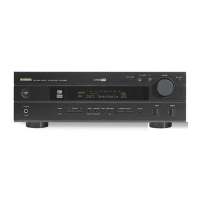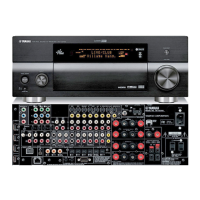
Do you have a question about the Yamaha DSP-AX559 and is the answer not in the manual?
| Type | AV Receiver |
|---|---|
| Audio Channels | 7.1 |
| Signal-to-Noise Ratio | 100 dB |
| Input Sensitivity | 200 mV |
| Frequency Response | 10 Hz - 100 kHz |
| Surround Sound | Dolby Digital, DTS |
| Input Sensitivity/Impedance | 47 kOhms (Line) |
| Video Connections | Component, Composite, S-Video |
| Audio Section | 192kHz/24-bit DACs for all channels |
| Power Output | 100W per channel (8 ohms, 20Hz-20kHz, 0.09% THD) |
Details on components requiring specific part replacements for optimal performance and safety.
Procedure for verifying proper insulation of exposed conductive surfaces after service.
Diagram and layout for the front panel of RX-V559 (U, C) models.
Diagram and layout for the front panel of RX-V559 (R, T, K, A, G, E, L) models.
Diagram and layout for the rear panel of RX-V559 (U, C) models.
Diagram and layout for the rear panel of RX-V559 (R) model.
Diagram and layout for the rear panel of RX-V559 (T) model.
Identification of the RAV322 and RAV323 remote control units.
Mapping of remote models to compatible receiver units.
Detailed specifications for the audio output, input, and processing sections.
Detailed specifications for video signal input, output, and conversion.
Detailed specifications for the FM tuner performance.
Detailed specifications for the AM tuner performance.
Physical measurements (Width x Height x Depth) of the unit.
Diagram showing the internal layout for RX-V559 and DSP-AX559 models.
Diagram showing the internal layout for the HTR-5950 model.
Step-by-step instructions for removing the unit's top cover.
Step-by-step instructions for removing the front panel assembly.
Step-by-step instructions for removing the side plates.
Step-by-step instructions for removing the sub chassis unit.
Instructions for removing the FUNCTION (1) printed circuit board.
Instructions for removing the DSP printed circuit board.
Instructions for removing the VIDEO printed circuit board.
Instructions for removing the FUNCTION (2) printed circuit board.
Instructions for removing the TUNER unit.
Instructions for removing the MAIN printed circuit boards.
Diagnostic mode for testing analog signal bypass functionality.
Diagnostic mode for testing DSP signal bypass functionality.
Diagnostic mode for checking RAM margin.
Diagnostic mode for testing Pro Logic processing.
Diagnostic mode for checking speaker settings.
Diagnostic mode for manual signal testing.
Diagnostic mode for factory preset initialization.
Diagnostic mode for checking Analog-to-Digital data.
Diagnostic mode for testing video signal processing.
Diagnostic mode for checking XM status.
Diagnostic mode for checking input signal status.
Diagnostic mode for checking DSP bus connections.
Diagnostic mode for checking protection history.
Diagnostic mode for viewing software versions.
Diagnostic mode for checking TI (DSP) boot status.
Procedure to start DIAG with protection functions temporarily disabled.
Screen indication when no protection history is present.
Screen indication when protection history is present.
Describes screen and FL indicator output during DIAG menu operation.
How to select and navigate through DIAG menus and sub-menus.
Explanation of the BYPASS menu item's functions.
Explanation of the RAM THROUGH menu item's functions.
Specific setting for RAM margin in RAM THROUGH.
Specific setting for RAM full bit in RAM THROUGH.
Explanation of the PRO LOGIC menu item's functions.
Explanation of the SPEAKERS SET menu item's functions.
Explanation of the XCH INPUT menu item's functions.
Explanation of the MIC CHECK menu item's functions.
Explanation of the DISPLAY CHECK menu item's functions.
Explanation of the MANUAL TEST menu item's functions.
Explanation of the FACTORY PRESET menu item's functions.
Explanation of the AD DATA CHECK menu item's functions.
Details on the functionality and behavior of panel keys.
Explanation of the XM STATUS menu item's functions.
Explanation of the iPod connection test menu item.
Explanation of the IF STATUS menu item's functions.
Explanation of the DSP BUS CHECK menu item's functions.
Explanation of the SWFR CUT OFF menu item's functions.
Explanation of the PROTECTION SETTING menu item's functions.
Explanation of the PROTECTION HISTORY menu item's functions.
Explanation of the SOFT SW menu item's functions.
Explanation of the SOFTWARE VERSION menu item's functions.
Explanation of the TI (DSP) BOOT menu item's functions.
Procedure to check and adjust idling current on the main amplifier board.
Diagram illustrating the pin connections for various components.
Diagram showing the assignment of display segments.
Detailed information on anode connections for display components.
Detailed pinout and function data for the main microprocessor IC.
Detailed pinout and function data for the audio interface IC.
Detailed pinout and function data for the decoder/post-processor IC.
Collection of pinout diagrams for different ICs and components.
High-level diagram illustrating the audio signal flow.
High-level diagram illustrating the video signal flow.
High-level diagram of control and power management systems.
Component layout for the DSP PCB (front view).
Component layout for the FUNCTION (1) PCB (front view).
Component layout for the OPERATION (1) PCB (front view).
Component layout for the MAIN (1) PCB (front view).
Component layout for the MAIN (2) PCB (front view).
Component layout for the DSP PCB (back view).
Component layout for the FUNCTION (1) PCB (front view).
Component layout for the FUNCTION (1) PCB (back view).
Component layout for the FUNCTION (2) PCB (front view).
Component layout for the FUNCTION (3) PCB (front view).
Component layout for the FUNCTION (4) PCB (front view).
Component layout for the FUNCTION (2) PCB (back view).
Component layout for the OPERATION (1) PCB (front view).
Component layout for the OPERATION (2) PCB (front view).
Component layout for the OPERATION (3) PCB (front view).
Component layout for the OPERATION (6) PCB (front view).
Component layout for the OPERATION (1) PCB (back view).
Component layout for the OPERATION (3) PCB (back view).
Component layout for the OPERATION (4) PCB (front view).
Component layout for the OPERATION (5) PCB (front view).
Component layout for the OPERATION (4) PCB (back view).
Component layout for the OPERATION (5) PCB (back view).
Component layout for the OPERATION (1) PCB (front view) for HTR-5950.
Component layout for the OPERATION (3) PCB (front view) for HTR-5950.
Component layout for the OPERATION (6) PCB (front view) for HTR-5950.
Component layout for the OPERATION (1) PCB (back view) for HTR-5950.
Component layout for the OPERATION (3) PCB (back view) for HTR-5950.
Component layout for the OPERATION (4) PCB (front view) for HTR-5950.
Component layout for the OPERATION (4) PCB (back view) for HTR-5950.
Component layout for the OPERATION (5) PCB (front view) for HTR-5950.
Component layout for the OPERATION (5) PCB (back view) for HTR-5950.
Component layout for the MAIN (1) PCB (front view).
Component layout for the MAIN (2) PCB (front view).
Component layout for the MAIN (4) PCB (front view).
Component layout for the MAIN (5) PCB (front view).
Component layout for the VIDEO PCB (front view).
Component layout for the VIDEO PCB (back view).
Part 1 of the DSP section schematic diagram.
Part 2 of the DSP section schematic diagram.
Part 3 of the DSP section schematic diagram.
Schematic diagrams for the FUNCTION circuits.
Schematic diagrams for the OPERATION circuits of specific models.
Schematic diagrams for the OPERATION circuits of the HTR-5950 model.
Schematic diagram of the main unit's circuits.
Schematic diagram of the video processing circuits.
Important safety warnings and notes regarding part replacement.
Categorized list of electrical components and their part numbers.
Assembly diagrams tailored to different model variants.
Circuit diagram for the RAV322 remote control.
Circuit diagram for the RAV323 remote control.
Step-by-step instructions for performing advanced setup configurations.












